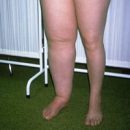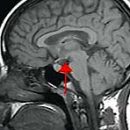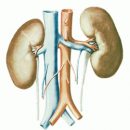The aneurysm of the abdominal department of the aorta occurs as a result of thinning the wall of the vessel and with a bundle or gap can lead to massive inner bleeding and even death. However, with early diagnosis, the aortic aortic aortic aneurysms can be heal.
Content
The concept of the aneurysm of the abdominal department of aorta
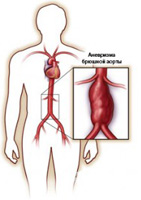 Aorta is the largest arterier in our body. Through her blood goes from the heart to all organs and tissues. Going out of the heart, the aorta passes through the chest, where it is called the Breast Department. In the abdominal cavity of Aorta is called the abdominal department. Through this, the aorta enters blood to the bottom of the body. In the lower sector of the abdomen of Aorta is divided into two branches - iliac arterys that participate in the blood supply to the lower extremities.
Aorta is the largest arterier in our body. Through her blood goes from the heart to all organs and tissues. Going out of the heart, the aorta passes through the chest, where it is called the Breast Department. In the abdominal cavity of Aorta is called the abdominal department. Through this, the aorta enters blood to the bottom of the body. In the lower sector of the abdomen of Aorta is divided into two branches - iliac arterys that participate in the blood supply to the lower extremities.
Special prevailing extension of the wall of the abdominal aorta, which arises due to thinning its wall, is called the aneurysm of the abdominal aortion. The fact is that with a rather powerful blood pressure on a weakened aorta wall, it occurs its balluloneal expansion of a certain area of its. Normally, the diameter of the aorta is 2 cm. However, with the aneurysm of the aorta, its diameter may be stretched to dangerous sizes. The danger of the aneurysm of any degree of aorta is that its bundle may occur or even the gap, which leads to massive internal bleeding and death.
In addition, aneurysm can contribute to the formation of blood clots. These blood clots carry blood flow to the organs, and can cause the blockage of the vessels, which leads to the strongest pains, as well as the impaired blood flow in the limb and its necrosis.
However, with early diagnosis of the aortic abdominal aortic aneurysms, it can be treated and even heal with modern efficient and safe treatment methods.
Basic symptoms of the disease
With the development of the aortic abdominal aortion aneurysm, the following symptoms may be marked:
- Feeling pulsation in the stomach similar to heartbeat
- Strong sudden pain in the stomach or bottom of the back. This may be a sign of aortic bundle
- In rare cases, pain in the footsteps may be marked due to blockage of blood vessels by tombami
With the bundle of the aneurysm of the patient may feel sudden weakness, dizziness, or pain and losing consciousness. This is a life-degrading state and in this case the patient is necessary for urgent medical care.
Causes of disease development
Doctors and researchers do not fully answer this question. The leading cause of the aorta aneurysm is considered to be inflammation, which contributes to the destruction of the wall of the aorta. Some researchers associate this inflammation of the aorta wall with the process of atherosclerosis or risk factors leading to atherosclerosis, for example, with high blood pressure. In atherosclerosis on the walls of the arteries and aortes, so-called atherosclerotic plaques are postponed. Over time, this process leads to a narrowing of the enlightenment of arteries, loss of their elasticity and weakness. There are other risk factors for the emergence of aortic aneurysm, except atherosclerosis:
- Men older than 60 years
- Availability of a direct relative (mother, brother), ill-meant aortic aneurysm
- high blood pressure
- smoking
The risk of aortic aneurysm increases with age. Men suffer a aortic aneurysm more often than women.
Diagnostics of the aortic abdominal aortion.
Most often aortic aneurysm is found during any procedure for studying the patient, for example, with ultrasound examination. If the doctor suspects you have aortic aneurysm, it can recommend:
- Ultrasonic examination of the abdominal cavity
- Computer tomography
- magnetic resonance tomography
Treatment methods
Expectant tactic
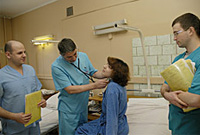 The doctor may recommend so calling the expectant tactics, which means that every 6 months you will be examined in order to identify any changes in the size of the aneurysm. To do this, it is necessary to regularly carry out an ultrasound study, or a computer tomography. This method is used to diagnose aneurysm with a diameter of 5 - 5.5 cm. If, in addition, you suffer high blood pressure, then the doctor can prescribe to you drugs that reduce it, which helps to reduce blood pressure on a weakened aorta wall. If you smoke, you need to quit smoking. Aneurysm itself is not going anywhere. Therefore, it is very important to constantly consult with your doctor, since with time aneurysm can achieve dangerous sizes, which is fraught with complications.
The doctor may recommend so calling the expectant tactics, which means that every 6 months you will be examined in order to identify any changes in the size of the aneurysm. To do this, it is necessary to regularly carry out an ultrasound study, or a computer tomography. This method is used to diagnose aneurysm with a diameter of 5 - 5.5 cm. If, in addition, you suffer high blood pressure, then the doctor can prescribe to you drugs that reduce it, which helps to reduce blood pressure on a weakened aorta wall. If you smoke, you need to quit smoking. Aneurysm itself is not going anywhere. Therefore, it is very important to constantly consult with your doctor, since with time aneurysm can achieve dangerous sizes, which is fraught with complications.
If aneurysm causes certain symptoms (pain, pulsation and t.D.) or its diameter is more than 5 - 5.5 cm, or in the dynamics there is an increase in its diameter, then the surgeon can offer you an open surgical intervention. The meaning of this operation is that the surgeon removes a weakened changed section of the wall of the aorta, and replaces its special «tube» - Aortic Prosthesis. The prosthesis is made from a special durable synthetic material (manually), diameter and size as a healthy aorta. The insertion of the aorta allows blood to flow freely. After surgery, the patient stays in the hospital 4 - 7 days. A full rehabilitation course may take about 2 - 3 months. The success of the aortic aneurysm treatment in this way is up to 90%.
Endovascular intervention
More modern method of treatment aortic aneurysms (and not only aortes) in this form of endovascular surgery as stenting. Term «Endovaascular» means that the operation is carried out inside the vessel with a special catheter, which is introduced into the clearance of the vessel. This type of operation is minimally invasive. This means that for the operation, the surgeon needs to produce only a small incision in the region of the grooves, through which the catheter is introduced. During the operation, the X-ray image is taken in real time, which allows the surgeon to control the process of conducting a catheter in the vessel. Next, the surgeon introduces a special device in the lumen of aorta - stent. This is a cylindrical shape of a wire frame that strengthens the wall of the aorta. Rehabilitation period after this type of operation is only 2 - 3 days. However, after the operation, it requires a rather frequent radiological control over the state and functioning of the installed stent. In addition, it may happen that this method does not suit you, for example, if you have a kidney pathology. It should be noted that in some cases the open operation is more acceptable.

